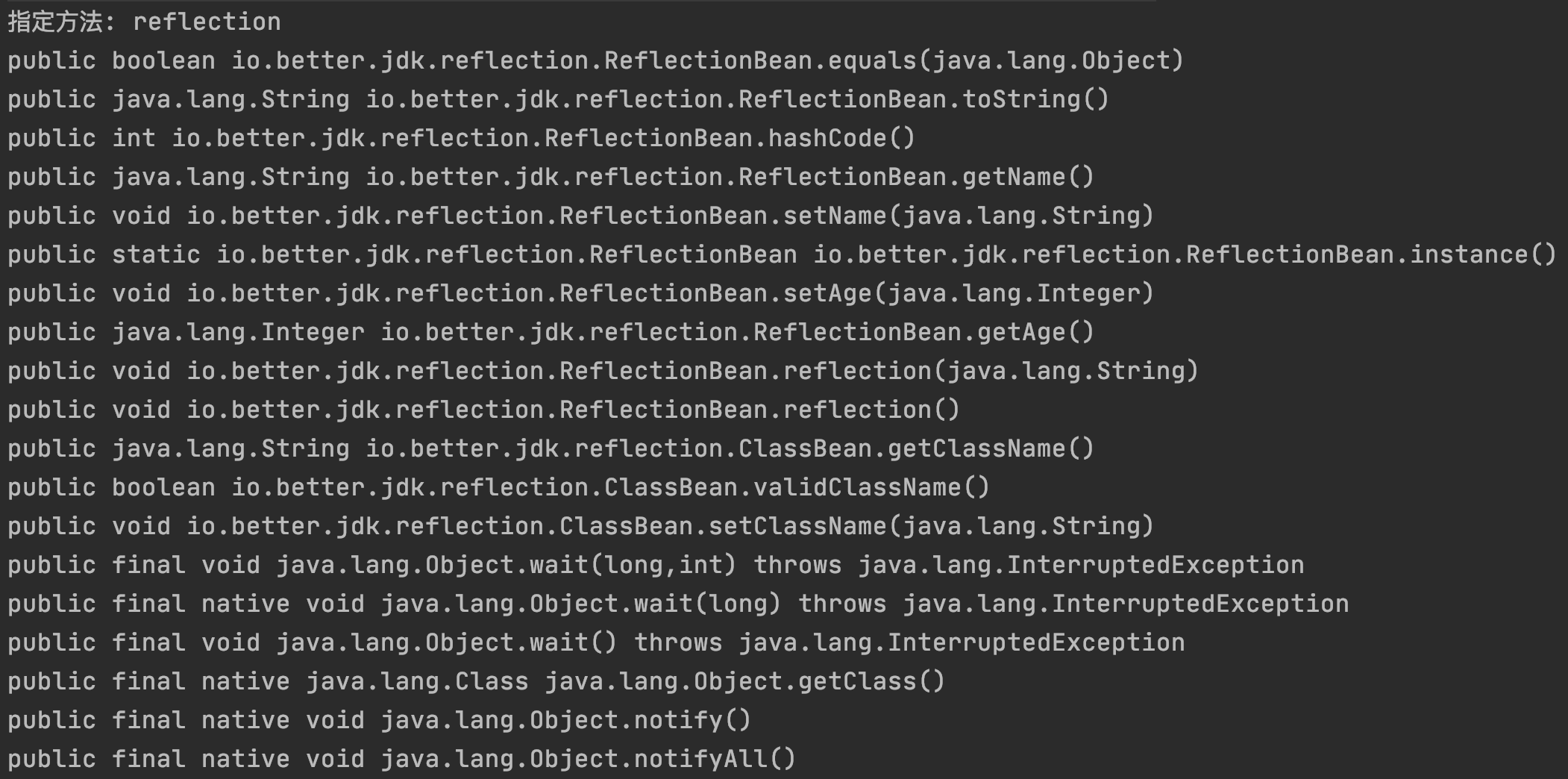该文章主要讲述Java中Reflection反射相关的API使用,以及一些常见问题。
Jdk-Reflection 概述 Java反射机制可以让我们在编译期(Compile Time)之外的运行期(Runtime)检查类,接口,变量以及方法的信息。反射还可以让我们在运行期实例化对象,调用方法,通过调用get/set方法获取变量的值。
Class 概述 Class的实例表示正在运行的Java应用程序的类和接口。 枚举是一种类和注释是一种接口。
每个数组都属于一个被映射成Class对象的类,该对象由具有相同元素类型和大小的所有数组共享。
原始类型(boolean, byte, char, short, int, long, float,double),以及关键字void也表示为Class对象。
特征 Class没有公共构造函数。 相反, Class对象由Java虚拟机的类加载并通过调用自动构造defineClass的类加载器方法 。
获取Class 获取Class对象的方式一共有三种:通过Class.forName("全路径包名"),类.class,类实例.getClass()。
示例代码:
1 2 3 4 5 6 Class<?> stringClass = Class.forName("java.lang.String" );new String ("1" ).getClass();
输出结果:
输出的结果证实了相同元素类型的Class实例是相同且共享的。
核心方法 在这个阶段会讲述Class类中常用方法的使用
ReflectionBean类:
1 2 3 4 5 6 7 8 9 10 11 12 13 14 15 16 17 18 19 20 21 22 23 24 25 26 27 public class ReflectionBean extends ClassBean {private String name;private Integer age;protected String address;public Boolean sex;public void reflection () {public void reflection (String name) {private boolean validInfo () {return name != null && name.length() > 0 && Objects.nonNull(age);public ReflectionBean (@NotNull String name) {this .name = name;private ReflectionBean (String name, Integer age) {this .name = name;this .age = age;public ReflectionBean () {public static ReflectionBean instance () {return new ReflectionBean ();
ClassBean类:
1 2 3 4 5 6 7 8 9 10 11 public class ClassBean {private String className;public boolean validClassName () {return className != null && className.length() > 0 ;public ClassBean () {public ClassBean (String className) {this .className = className;
Construtor一个Constructor对应着类中的一个构造函数,可以使用Class.getConstructors()获取指定类所有的构造函数(私有无法获取)。也可以使用Class.getConstructor(Class<?> ... paramType)获取指定参数的构造方法。
测试代码:
1 2 3 4 5 6 7 8 9 10 11 12 13 14 @Test public void testConstructor () throws NoSuchMethodException {
输出结果:
1 2 3 4 5 io.better.jdk.reflection.ReflectionBean
上面代码中演示了Class.getConstructors和Class.getConstructor(Class<?> ..params)获取构造方法。
通过Constructor对象我们可以获取到构造方法中的注解,参数,参数类型,参数数量等信息,但这两种方式都不能获取私有构造方法。那如何获取私有的构造器呢?
使用getDeclaredConstructors()和getDeclaredConstructor(Class<?> ..params)可以获取到类中所有的构造方法,包括私有的。
1 2 3 4 5 6 7 8 9 @Test public void testGetDeclaredConstructors () throws NoSuchMethodException {
介绍完Constructor对象的获取方式后,接下来通过Constructor对象来实例化目标对象。
我们可以通过Constructor.newInstance(Object ...params)方法传入实际的参数来创建目标对象。
1 2 3 4 5 6 7 8 9 10 11 12 13 14 15 16 17 18 @Test public void testConstructorInstance () throws Exception {ReflectionBean reflectionBean = stringConstructor.newInstance("Constructor" );true );"DeclaredConstructor" , 1 );
Method讲完Constructor的使用,已经能通过其创建对象了,那如何调用目标对象中的方法呢?
与Constructor类似,Class提供了getMethods,getMethod(String methodName, Class<?> ...paramType)方法分别获取执行类的所有方法(包括静态方法,父类继承下来的方法)和指定方法。
1 2 3 4 5 6 7 8 9 10 11 12 13 @Test public void testGetMethod () throws Exception {Method method = reflectionBeanClass.getMethod("reflection" , String.class);"指定方法: " + method.getName());for (Method item : methods) {
执行结果:
从结果可以看出,私有方法未被获取到,和Constructor类似这两个方法不能获取私有方法,要想获取私有方法必须使用
1 2 3 4 5 6 7 8 9 10 11 12 @Test public void testGetDeclaredMethod () throws Exception {Method method = reflectionBeanClass.getDeclaredMethod("validInfo" );
执行结果:
1 2 validInfo
获取类中方法已经了解,接下一来尝试调用执行一下方法。
与Constructor不太一样,要想执行方法需要调用invoke(Object obj, Object... args)。该方法接受两个参数,第一个为目标对象(即拥有此方法的类对象),第二为方法所需的参数。当调用私有方法时做法与Constructor一致。
1 2 3 4 5 6 7 8 9 10 11 12 13 @Test public void testInvokedMethod () throws Exception {true );ReflectionBean object = constructor.newInstance("TEST" , 1 );Method method = reflectionBeanClass.getDeclaredMethod("validInfo" );true );Object methodResult = method.invoke(object);
Field与Method类似,我们可以使用getFields,getField(String name)两个方法来获取类中所有非私有的字段。
1 2 3 4 5 6 7 8 9 10 11 @Test public void testGetField () throws Exception {for (Field field : fields) {
这两个方法只能获取公共字段(public修饰),private,default,protected都获取不到。
我们可以使用getDeclaredFields,getDeclaredField两个方法来获取所有的字段和指定字段,
1 2 3 4 5 6 7 8 9 10 11 @Test public void testGetDeclaredField () throws Exception {for (Field field : fields) {Field age = reflectionBeanClass.getDeclaredField("age" );
执行结果:
如果想要获取某个字段对应的值,则需要调用get(Object obj)方法,传入包含此字段的目标类对象,私有字段需要调用setAccessible()方法。
1 2 3 4 5 6 7 8 9 10 11 12 13 14 15 16 @Test public void testFieldMethod () throws Exception {true );ReflectionBean object = constructor.newInstance("TEST" , 1 );Field age = reflectionBeanClass.getDeclaredField("age" );true );
总结 Constructor,Method,Field三个类分别 对应类中 的构造方法、方法、字段,分别提供了getDeclared开头的方法来获取对应所有的信息。
其他方法 newInstance()在获取到类的Class对象时,可以通过调用此方法来创建目标类对象,该方法会默认调用类的无参构造方法来创建对象。
1 2 3 4 5 6 @Test public void testNewInstance () throws Exception {ReflectionBean reflectionBean = reflectionBeanClass.newInstance();
isInstance(Object obj)该方法用于断定指定Object是赋值兼容与此表示的对象Class ,等效instanceof运算符。
1 2 3 4 Class<String> stringClass = String.class;"test" ); 123456 );
使用场景 反射进行数组扩容 1 2 3 4 5 6 7 8 9 10 11 12 13 14 15 16 17 18 19 @Test public void testArrayExtension () {new String []{"1" , "2" , "3" , "4" , "5" };"原始数组长度: " + stringArray.length);Object newStringArray = ArrayExtension(stringArray, stringArray.length * 2 );"扩容后数组长度: " + Array.getLength(newStringArray));public Object ArrayExtension (Object sourceArray, int extensionLength) {if (extensionLength < Array.getLength(sourceArray))throw new IllegalArgumentException ("扩展长度不合法" );Object newStringArray = Array.newInstance(componentType, extensionLength);0 , newStringArray, 0 , Array.getLength(sourceArray));return newStringArray;
反射跳过泛型检查 1 2 3 4 5 6 7 8 9 10 11 12 13 14 15 16 @Test public void testJumpTypeCheck () throws Exception {new ArrayList <>();"a" );"b" );"c" );extends List > listClass = stringList.getClass();Method addMethod = listClass.getMethod("add" , Object.class);1 );

